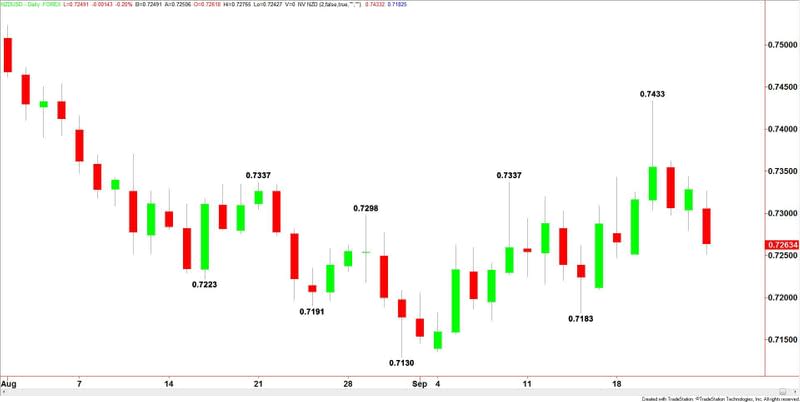AUD/USD and NZD/USD Fundamental Daily Forecast – NZ Falls on Bigger-Than-Expected Trade Deficit in August
The Australian and New Zealand Dollars finished lower on Monday. Both reacted to lower demand for higher-yielding assets. Additional selling pressure on the Kiwi came from last week-end’s elections that resulted in mixed results.
The AUD/USD settled at .7936, down 0.0023 or -0.29% and the NZD/USD finished the session at .7263, down 0.0065 or -0.88%.

Both the Australian and New Zealand Dollars succumbed to selling pressure after North Korea’s foreign minister Ri Yong Ho said U.S. President Donald Trump had declared war on North Korea. Ri added that North Korea has the right to shoot down strategic U.S. bombers even if they are not in North Korean airspace. This news drove up demand for safe haven assets and drove down demand for higher risk assets.
Political uncertainty drove the New Zealand Dollar lower as the ruling National Party won the largest number of votes in a weekend election but failed to secure a ruling majority, with a protracted period of coalition building now a possibility. The decline in the NZD/USD was the currency’s biggest drop in about a month.
In other news, Federal Reserve Bank of New York President William Dudley said the U.S. central bank should maintain its gradual pace of policy tightenings as temporary factors holding down price pressures fade. This signaled the Fed remains on track to raise interest rates again in December.
Chicago Fed President Charles Evans offered a more cautious perspective on Monday. Speaking in Grand Rapids, Michigan, Evans said that he was “broadly comfortable” with the median estimate of the Fed’s quarterly projections, which showed its overnight policy rate ending 2019 at 2.7 percent.
Evans also said, “We (the Fed) should avoid taking policy steps that could be misread as a lack of concern over the inflation outlook. In my view, that would be a policy misstep that would further delay achieving our inflation objective.”
Minneapolis Fed President Neel Kashkari said on Monday that he sees no need for the U.S. Federal Reserve to raise interest rates further as he sees no evidence recent weak inflation data is set to improve.
“When I look at the economy I don’t see any signs that the economy is close to overheating,” said Kashkari, a voter on the central bank’s rate-setting committee this year, during an appearance at the University of North Dakota. “I don’t see inflation taking off so I see no need to tap the brakes.”

Forecast
The AUD/USD is trading flat early Tuesday as investors showed almost response to comments from Reserve Bank of Australia Assistant Governor Michele Bullock. She said high levels of debt leave households vulnerable to shocks. She also added that the RBA will take this vulnerability into account for monetary policy.
In addition to concerns over the election results in New Zealand, NZD/USD traders are also reacting to the posting of a bigger-than-expected goods trade deficit in August as exports of milk power, butter and cheese declined and imports of crude oil and petroleum products jumped higher.
New Zealand had a trade deficit of $1.235 billion in August, little changed from the $1.24 billion deficit in August last year but ahead of the $968 million average monthly deficit in August over the last five years, Statistics New Zealand said. The deficit was bigger than the $825 million median forecast in a Bloomberg survey of 10 economists.
On Tuesday, investors will get the opportunity to react to U.S. reports on housing, consumer confidence and manufacturing. FOMC Member Lael Brainard is also scheduled to speak at 1430 GMT.
The major market moving event today is likely to be Fed Chair Janet Yellen’s speech at 1645 GMT. Yellen’s speech is expected to be on “inflation, uncertainty, and monetary policy”. She could create volatility in the gold, Forex, Treasury and stock markets if she mentions anything about the timing of the next Fed rate hike.
This article was originally posted on FX Empire

 Yahoo Finance
Yahoo Finance 